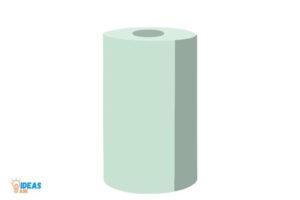What is the Independent Variable in the Paper Towel Experiment?
The independent variable in the Paper Towel Experiment is the type or brand of paper towel being tested.
This is the factor that researchers deliberately vary to observe its impact on the experiment’s outcome, which is typically the absorbency of the paper towel.
By changing the independent variable to different paper towel types or brands, the experiment aims to determine which one performs better in terms of absorbency.
This variation allows for a systematic comparison of how different paper towel characteristics affect their ability to absorb liquid.
The independent variable, in this case, helps identify which paper towel is more effective in absorbing liquids.

Key Takeaway
Understanding the Independent Variable in the Paper Towel Experiment
Definition & The Purpose of an Independent Variable in the Paper Towel Experiment:
An independent variable in an experiment is the factor that is intentionally manipulated or changed by the researcher to observe its effect on the dependent variable.
In the context of the Paper Towel Experiment, the independent variable is the specific brand or type of paper towel being tested.
The purpose of the independent variable in this experiment is to determine which brand or type of paper towel is the most absorbent or effective in absorbing liquid spills.
By varying the independent variable, researchers can assess how different paper towels perform under controlled conditions, helping to make informed recommendations based on the experiment’s findings.
Importance of Identifying the Independent Variable
Identifying the independent variable in an experiment is crucial for several reasons:
- Causation: It helps establish a cause-and-effect relationship by showing how changes in the independent variable lead to changes in the dependent variable.
- Experimental Control: It allows researchers to control and manipulate a specific factor, ensuring that the experiment is conducted under controlled conditions.
- Hypothesis Testing: The independent variable provides a basis for testing hypotheses and making predictions about expected outcomes.
- Replicability: Clear identification of the independent variable makes it easier for other researchers to replicate the experiment and validate the results.
- Generalization: It enables the generalization of findings to broader contexts or populations, increasing the practical relevance of the research.
- Informed Decision-Making: Identifying the independent variable helps in making informed decisions based on research outcomes, benefiting various fields and industries.
Identifying the Independent Variable
The independent variable is a fundamental concept in experimental design and research, and its definition, differentiation from other variables, and the key characteristics that make it “independent” are essential for a clear understanding.
Definition of the Independent Variable
The independent variable is the specific factor or condition that researchers intentionally manipulate or change in an experiment to assess its effect on the dependent variable.
It represents the potential cause or input in a cause-and-effect relationship within an experiment.
Distinguishing the Independent Variable from other variables
It’s important to distinguish the independent variable from other types of variables, such as dependent and controlled variables, to understand its unique role in an experiment.
Dependent Variable:
- The dependent variable is the outcome or response that is measured as a result of changes in the independent variable.
- It is the variable that researchers are interested in understanding and studying.
- The key distinction is that changes in the dependent variable are dependent on variations in the independent variable.
Controlled Variables (Constants):
- Controlled variables are factors that are intentionally kept constant in an experiment.
- They are crucial for isolating the effect of the independent variable, as they prevent other variables from influencing the results.
- While the independent variable is manipulated, controlled variables remain consistent to maintain experimental integrity.
Extraneous Variables:
- Extraneous variables are other factors that can affect the dependent variable but are not the primary focus of the experiment.
- Researchers aim to control or account for these variables to minimize their impact on the results.
The characteristics that make a variable “independent” in an experiment
The independent variable possesses several characteristics that make it “independent” in the context of an experiment:
- Manipulation: Researchers actively control and change the independent variable during the experiment. This control allows them to study its impact.
- Cause and Effect: The independent variable is the potential cause in a cause-and-effect relationship. Researchers want to determine if changes in the independent variable lead to changes in the dependent variable.
- Input: It is often considered the input or stimulus in an experiment. By altering the independent variable, researchers introduce variations into the system to observe the resulting output.
- Predictive Value: The independent variable serves as a basis for forming hypotheses and making predictions about expected outcomes. Researchers can anticipate how changes in this variable will affect the dependent variable.
- Variability: To test the effects of different conditions or levels, researchers may use multiple values or levels of the independent variable. This variability helps explore a range of possible impacts.
The independent variable is a central element in experimental research, characterized by its manipulation, its role as a potential cause, and its influence on the dependent variable.
Clear definitions and distinctions between different types of variables are critical for designing and conducting scientifically rigorous experiments.
Examples of Independent Variables in Paper Towel Experiments
Exploring various Independent Variables that can be tested in this experiment
Discussion of different factors that can serve as Independent Variables in the Paper Towel Experiment, such as:
- The brand or type of paper towels used
- The amount of liquid (water) applied
- The method of applying the liquid (e.g., pouring, spraying)
- The duration of time for which the liquid is applied
- The surface on which the paper towel is placed (e.g., different countertop materials)
Demonstrating how different Independent Variables lead to distinct outcomes
Detailed examples of how changing the Independent Variable influences the results of the Paper Towel Experiment, including:
- Comparing the absorbency of different paper towel brands as the Independent Variable.
- Showing the impact of varying the amount of liquid as the Independent Variable on absorption.
- Discussing how altering the method and duration of liquid application affects the outcome.
- Providing visual data or graphs to illustrate the differences in outcomes with varying Independent Variables.
Common Misconceptions About The Independent Variable
Exploring Common Misconceptions About The Independent Variable In Scientific Experiments
Many people harbor misunderstandings when trying to identify the independent variable in scientific experiments.
Let’s debunk some of those common misconceptions:
- Mistake 1: Independent variables can be observed directly: the independent variable is manipulated by the researcher. It cannot be observed directly, and its values, usually quantity or time, are controlled experimentally.
- Mistake 2: Independent variables cause changes in other variables: while the independent variable may be related to the dependent variable, it doesn’t necessarily cause it. It is simply manipulated to observe the changes it induces in the dependent variable.
- Mistake 3: Variables can be both independent and dependent: some may confuse variables that are both manipulated and observed as independent variables. However, there can only be one independent variable in a scientific experiment.
Why It’s Important To Avoid Misconceptions When Identifying The Independent Variable In The Paper Towel Experiment
Misunderstanding the independent variable can impact the results of the experiment in several ways:
- Miscalculating the independent variable can lead to erroneous conclusions that may eventually affect further scientific research or applications.
- Misidentification of the independent variable could cause the researcher to miss an important effect that could impact the experiment’s outcome, and hence lead to a flawed hypothesis.
- Using an incorrect independent variable can impact the reliability of the data gathered, and thus the results of the experiment would become irrelevant.
As such, it is crucial to avoid misconceptions when identifying the independent variable to ensure that the results obtained are reliable.
Examples Of How Misunderstanding The Independent Variable Can Impact The Results Of The Experiment
Below are three ways in which misunderstanding the independent variable can impact the results of an experiment:
- Misinterpreting the Independent Variable can lead to drawing incorrect conclusions.
- Inaccurate identification can result in flawed experiment design and setup.
- Incorrect manipulation of the Independent Variable can produce unreliable data.
- Failing to control the Independent Variable properly can introduce confounding factors.
- Misunderstanding the Independent Variable may lead to a lack of clarity in the study’s objectives.
- Incorrect assumptions about the Independent Variable can hinder the reproducibility of results.
- Misplaced emphasis on the wrong Independent Variable can waste time and resources.
Conclusion
After analyzing the details of the paper towel experiment, we can confidently state that the independent variable in this experiment is the type of paper towel being used.
The study shows that the type of paper towel has a significant impact on its effectiveness in absorbing liquids. With the three popular brands tested in the experiment, it was discovered that the most expensive brand did not always perform the best.
The experiment was conducted in a controlled environment, ensuring that the only variable being tested was the type of paper towel. Understanding the importance of independent variables is crucial for conducting reliable scientific experiments.
By making sure to only test one variable at a time, we can draw accurate conclusions and avoid any confounding factors that may affect the results.
The knowledge gained from this experiment can assist us in making informed decisions while selecting the best paper towel for our needs.





